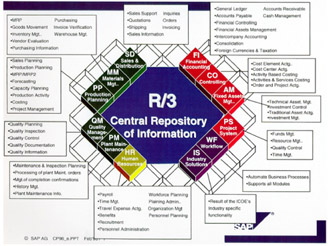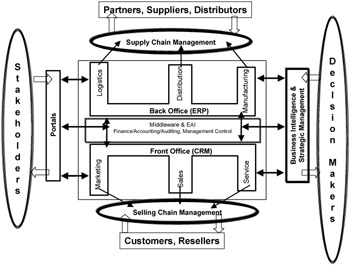The Evolution of the Enterprise System Suite: From ERP to E-Business
|
The White Collar Revolution is here. (Finally.) The White Collar Revolution will embrace—ready or not!—90+ percent of workers in the next 10 or so years. And most of us are not ready. It's elementary, my dear Watson. Most white collar jobs—as we know them—will disappear as we get the ERP/ Enterprise Resource Planning—etc.—"stuff" right. You read that correctly, colleagues: 90+ percent. Gone. As in: Sayonara. White collar world circa 2004 is going to make "re-engineering" circa 1994 look like very small change indeed.
Tom Peters (1999)
In the early 1990s, SAP AG, a German company headquartered in Walldorf, delivered to the U.S. market Enterprise Resource Planning (a.k.a., ERP). ERP represented packaged, customizable "off-the-shelf" integrated application software delivered on a client/server ERP platform, possessing broad and deep functionality and real-time data. Furthermore, ERP packages were designed based on "best" industry practices and these practices were then inherently available to all companies implementing the package.
The most defining characteristic of ERP systems, when implemented properly, is integration. Integration such as this enables process-orientation in an organization. And thus, allows a firm to be customer-centric. Tom Davenport (1993) and Michael Hammer (1996) defined the process organization and how ERP is used to create the process organization. The resulting core processes that all businesses could relate to including Make (Production), Buy (Procurement), and Sell (Sales), and the core supporting processes included Human Resource Management and Accounting and Finance. Figure 1 illustrates ERP as it was presented by SAP.

Figure 1: ERP as Defined by SAP R/3 (circa 1997).
In a more specific sense, the term Enterprise Systems (ES) has been used more recently to refer to the combination of people, business processes, and technical infrastructure required to run enterprise application software (EAS). Figure 1 illustrates only major business applications that were popular at the time this illustration was first published in the early 1990s. Miranda (1999) identified 10 components of "true" ERP Systems: Modular Integration; Common and Relational Database; Client/Server Technology; Best Business Practices and Process Reengineering; Workflow Capabilities; Powerful Development Toolsets; Drill Down/Audit Trail Capabilities; Flexible Chart-of-Accounts (COA); Advanced Reporting and Analysis; and Web Enabling and Internet Capabilities.
Today, as we see below, there are suites of EAS solutions that extend the enterprise beyond the ERP domain. These concepts, identified by Miranda, remain as important as ERP systems but are integrated into an even more comprehensive system that has greater functionality, greater intelligence and decision-making features with the ability to reach out to other organizations. For lack of a better term, e-business systems have become the term used to describe these systems. E-business systems application vendors have viewed e-business in the following manner. The core of e-business is Enterprise Resource Planning (ERP) consisting of Manufacturing Planning and Execution (Make), Procurement (Buy), and Order Fulfillment (Sell) at its core, surrounded by the key support functions of human resource management, financial management and accounting, and product design and development. When ERP is extended to take full use of the Internet, and subsequent functionality developed during the birth of the Internet, a collection of complementary applications emerge as: Supply Chain Management (SCM), Supplier Relationship Management (SRM), Customer Relationship Management (CRM), Employee Resource Management (ERM), Corporate Financial Management (CFM), Product Life-Cycle Management (PLM), and Strategic Enterprise Management. These application solutions are connected to the outside world via Portals (to employees, customers, and suppliers) and Marketplace Exchanges (to the systems utilized by employees, customers, and suppliers). Another perspective on these systems is provided in Figure 2, adapted from Kalikota and Robinson (2001).

Figure 2: e-Business Systems Suite. (Adapted from Kalikota and Robinson, 2002.)
It could be argued that the most important lesson learned from the 1990s is that human and organizational issues account for the majority of the challenges facing an organization's transition to a new computing or business environment. Software vendors have developed sophisticated human-computer interfaces and executive information systems, but many employees (CEOs included) do not have the technical expertise to fully utilize such applications. As technology advances, business and society must learn how to effectively deploy and infuse this technology through their organizations. Will the technology ease the pain or will future generations of professionals have to deal with such a large and profound technology literacy gap? The answer remains to be seen. The next section explores the most critical components of the emerging e-business systems suite. This presentation may provide to the reader a wholistic perspective of the systems at the foundation of the intelligent enterprise of the 21st century.
|
EAN: 2147483647
Pages: 195